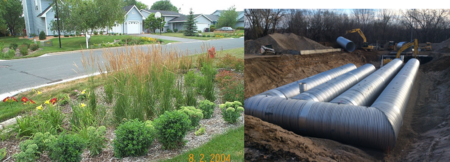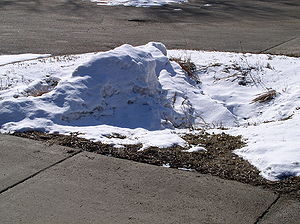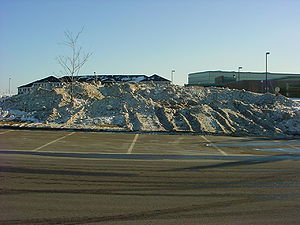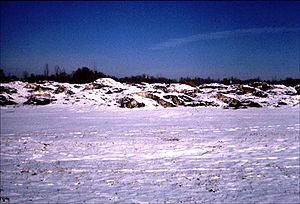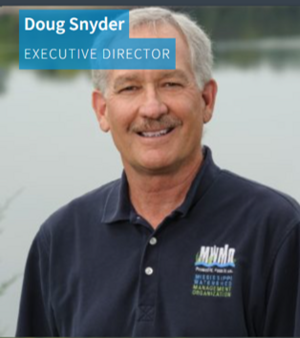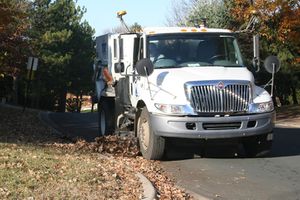
Difference between revisions of "Minnesota Stormwater Manual email Updates"
m |
m |
||
| Line 14: | Line 14: | ||
*'''Stormwater wiki page updates''': We are in the process of going through every page in the wiki. Revised pages will include updating links, updating information as needed, providing definitions where appropriate using hover boxes, improving tables and visuals if appropriate, and creating pdfs of most pages. Some pages may contain video summaries. Remember that pdfs are static. To see when the last update occurred, scroll to the bottom and view the date of the last update or go to the Page Information link in the left toolbar. | *'''Stormwater wiki page updates''': We are in the process of going through every page in the wiki. Revised pages will include updating links, updating information as needed, providing definitions where appropriate using hover boxes, improving tables and visuals if appropriate, and creating pdfs of most pages. Some pages may contain video summaries. Remember that pdfs are static. To see when the last update occurred, scroll to the bottom and view the date of the last update or go to the Page Information link in the left toolbar. | ||
| − | ===What | + | ===What are we working on (July 2022)=== |
*Continue reorganizing the wiki and updating pages over the next 9 months | *Continue reorganizing the wiki and updating pages over the next 9 months | ||
*Create new content on street sweeping. We are working with the University of Minnesota to develop content focusing on establishing a street sweeping program for water quality purposes. New material will include | *Create new content on street sweeping. We are working with the University of Minnesota to develop content focusing on establishing a street sweeping program for water quality purposes. New material will include | ||
| Line 20: | Line 20: | ||
*Vegetation | *Vegetation | ||
*Green infrastructure | *Green infrastructure | ||
| + | |||
| + | ===Featured article - Green infrastructure and alphabet soup (July 2022)=== | ||
| + | We are continually bombarded with new terminology and acronyms. These days, an important focus of stormwater is green infrastructure, anture-based solutions, and sustainability. What do these mean and is it important to know the distinction between these? | ||
| + | |||
| + | To begin, there is no universal definition of these. So this featured article provides our view on this topic. If you want some basic definitions, we have a page called [[Green infrastructure and green stormwater infrastructure terminology]]. | ||
| + | |||
| + | |||
| + | |||
| + | ===In the news and events (July, 2022)=== | ||
===[https://stormwater.pca.state.mn.us/index.php?title=Stormwater_quizzes#Vegetation_quiz Take the vegetation quiz]=== | ===[https://stormwater.pca.state.mn.us/index.php?title=Stormwater_quizzes#Vegetation_quiz Take the vegetation quiz]=== | ||
Revision as of 15:41, 13 July 2022
Over the past several years we've heard from people suggesting they be notified when updates are made to the Minnesota Stormwater Manual. We have also identified several stormwater management concerns and felt that focused communication on these specific issues might be useful. We therefore decided that periodic emails to subscribers would be one way of notifying practitioners about updates to the Manual and focus on specific stormwater issues. Emails are sent periodically, roughly every 6-12 weeks.
The emails contain only a short description of updates and other information. This page provides more detailed information. It is organized by the approximate dates when emails are sent to subscribers. We welcome recommendations for featured topics and links to case studies and other items of information. Please contact Mike Trojan at the MPCA..
Subscribe to the email list here.
July 2022
Although it has been several months since the last update to the Stormwater Manual wiki, we have not added a lot of new material. However, we are beginning a review and reorganization process for the wiki.
Updates to the Manual wiki (July 2022)
- Planning green stormwater infrastructure (GSI) projects and practices: We continue to add information to the green infrastructure section of the manual. A new page called Planning green stormwater infrastructure projects and practices was created. The page provides information on how to plan for incorporating GSI into new development and retrofit projects. Several links are included, including links to ordinances, checklists for identifying barriers to implementing GSI, planning case studies, cost information, potential funding sources, and more.
- Operation and maintenance considerations for vegetation in stormwater management: We've begun incorporating information on vegetation into the manual. A recently created page called Operation and maintenance considerations for vegetation in stormwater management provides information on establishing vegetation at a site and creating a vegetation management plan. This page is still under review.
- Stormwater wiki reorganization: The wiki has over 2000 pages and over 1500 images. It has become disorganized. We've begun the process of evaluating a better structure for organizing the content. This process will include deleting several hundred pages and condensing information. We hope to have a draft structure within the next month or two.
- Stormwater wiki page updates: We are in the process of going through every page in the wiki. Revised pages will include updating links, updating information as needed, providing definitions where appropriate using hover boxes, improving tables and visuals if appropriate, and creating pdfs of most pages. Some pages may contain video summaries. Remember that pdfs are static. To see when the last update occurred, scroll to the bottom and view the date of the last update or go to the Page Information link in the left toolbar.
What are we working on (July 2022)
- Continue reorganizing the wiki and updating pages over the next 9 months
- Create new content on street sweeping. We are working with the University of Minnesota to develop content focusing on establishing a street sweeping program for water quality purposes. New material will include
- Iron-enhanced sand filters
- Vegetation
- Green infrastructure
Featured article - Green infrastructure and alphabet soup (July 2022)
We are continually bombarded with new terminology and acronyms. These days, an important focus of stormwater is green infrastructure, anture-based solutions, and sustainability. What do these mean and is it important to know the distinction between these?
To begin, there is no universal definition of these. So this featured article provides our view on this topic. If you want some basic definitions, we have a page called Green infrastructure and green stormwater infrastructure terminology.
In the news and events (July, 2022)
Take the vegetation quiz
February 2022
It's been several months since our last update, as we were wrapping up a number of projects.
Updates to the Manual (February 2022)
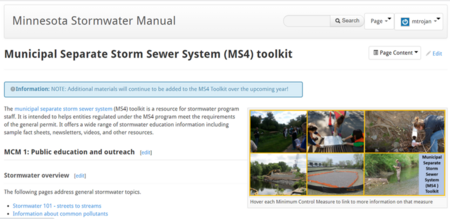
- Stormwater MS4 toolkit. The MS4 (Municipal Separate Storm Sewer System) toolkit is a resource for local stormwater program staff. It is intended to help entities regulated under the MS4 program meet the requirements of the general permit. It offers a wide range of stormwater education information including sample fact sheets, newsletters, videos, and other resources. The toolkit was recently updated with information on stormwater management, including new videos. To see the new information, visit this page.
- Street sweeping: We continue to update information on street sweeping. Below is a summary of the latest updates.
- Recommended street sweeping practices for water quality purposes: This page includes a summary of recommended practices at the top of the page.
- Case studies for street sweeping: In December we conducted interviews with staff from seven cities that were implementing street sweeping for water quality purposes. The interviews illustrate how cities are modifying their sweeping efforts to enhance water quality objectives. Information from these interviews was used to develop the recommended practices mentioned in the previous bullet.
- Street Sweeping Phosphorus Credit Calculator How-to-Guide: This handy quick guide summarizes how to use the street sweeping calculator.
- What's next: We plan on meeting with several stakeholders to identify additional tools and resources they would like to help continue enhancing street sweeping for water quality. Following this meeting, we will determine what tools and resources we can produce. These will be incorporated into the Stormwater Manual as appropriate and further communicated through other means such as newsletters.
- We have developed total suspended solid (TSS) and total phosphorus (TP) credits for manufactured treatment devices (mtds). These credits represent the reduction in TSS or TP loading expressed as a percent for water treated by the device. There are additional needs for crediting mtds, including the following.
- Calculation of annual load reductions. The credits established for mtds only represent the percent reduction for water treated by a device. The volume of water treated by a device, typically expressed on an annual average basis, must be determined before calculating an annual pollutant reduction for the device.
- Credits for dissolved phosphorus (DP). TP credits are currently limited based on the assumption the devices are not removing dissolved phosphorus. The credit scheme includes three tiers. Tier 3 will include credits for removing DP. Before Tier 3 credits can be determined, however, we must develop methods for calculating the performance of a device with respect to DP. Ultimately, DP credits may be given for devices that have a mechanism for removing DP (e.g. an amendment) or that retain runoff water (e.g. through infiltration).
- Time frame: We anticipate completing guidance for calculating annual loads and for assigning Tier 3 credits by this summer.
- We created a page called Guidance and recommendations for storing transported snow and for on-site snow storage. This page provides recommendations for managing and storing snow, including information for snow collected from impervious surfaces and transported to a storage location as well as information on storing snow on-site. The recommendations focus on protection of surface waters (lakes, rivers, wetlands), except where otherwise noted. The page is largely populated but will be undergoing some additions in February, 2022.
What are we working on (February 2022)
- Iron enhanced sand filters. In 2019 we compiled a spreadsheet containing information on 166 iron-enhanced sand filters (IESFs) in Minnesota. At the time there was limited performance information for these bmps. We have executed a work order to revisit a subset of these bmps and analyze their performance. The resulting information will be used to update guidance on design, construction, operation, and maintenance of IESFs. Projected timeline - late summer 2022.
- Vegetation: We have created a new page in the wiki called Plant and vegetation information for stormwater management. This page provides a framework for information on plants and vegetation that will eventually be incorporated into the wiki. We have a current work order to develop information on site assessment, preparation, design considerations and recommendations for vegetation in stormwater management and on operation and maintenance considerations for vegetation in stormwater management. We anticipate this information will be available in late summer, 2022.
- Green infrastructure: A long-term project to improve information on Green Stormwater Infrastructure in the Manual started in 2021. This work will be completed in phases. A current work order addresses design considerations for green stormwater infrastructure best management practices. We anticipate this work being completed by late summer, 2022.
- Street sweeping: The MPCA is working with University of Minnesota Extension staff to identify tool and resource needs to promote street sweeping.
- Management and disposal of bioretention media. In spring, 2022, we anticipate having guidance on how to evaluate and manage bioretention media at the end of its life cycle.
Featured article - Managing chloride in stormwater runoff (February 2022)
It is widely acknowledged the most effective strategy for protecting receiving waters from chloride pollution is by reducing use of chloride-deicers. But elimination of deicers is not practical in the foreseeable future. Are there ways to manage urban runoff having elevated chloride concentrations?
A workgroup of stormwater and groundwater professionals recently produced a white paper, published by the Minnesota Groundwater Association, that addresses this topic. The paper, titled Impacts of Stormwater Infiltration on Chloride in Minnesota Groundwater, provides a discussion of chloride in stormwater runoff and potential groundwater impacts associated with infiltration of stormwater runoff.
Chloride concentrations in stormwater runoff are highly variable and seasonally dependent. Concentrations in winter range from several hundred mg/L to as high as 40,000 mg/L, with typical concentrations being closer to 1000 mg/L. Concentrations outside the deicing season are typically less than 50 mg/L, with concentrations decreasing from spring into fall. Chloride is toxic to aquatic life, with the aquatic life standard being 230 mg/L. The drinking water standard is based on taste and is 250 mg/L. Chloride is also toxic to vegetation, can corrode materials, and can inhibit lake mixing, which may in turn result in changes in phosphorus cycling.
Though chloride is not retained in soil, studies indicate it is attenuated in soil. As a result, there is a lag time between chloride entering soil, including a media-based stormwater best management practice, and its eventual movement to a receiving water, be that a lake, stream, river, or aquifer. Understanding this process and the eventual receiving water can help us manage runoff containing chloride. The white paper provides the following conclusions.
- Where deicer use is not extensive, infiltration practices are protective of receiving surface waters. Infiltration may increase groundwater chloride concentrations, but not to concerning levels. In some cases, infiltration may offset other chloride sources (e.g. leaking infrastructure) and lead to water quality improvements.
- Where deicing is extensive, infiltration practices will likely lead to criteria exceedances in shallow groundwater. This chloride-enriched groundwater may migrate to local streams or drinking water aquifers.
- In baseflow-fed urban streams impaired by high winter chloride concentrations, infiltration practices may decrease instream winter concentrations through dilution. In-stream summer concentrations will be a function of concentrations in groundwater. If groundwater exceeds the aquatic life standard of 230 mg/L, baseflow-fed summer stream concentrations may exceed the standard.
The white paper also provides several recommendations for managing stormwater runoff that contains elevated concentrations of chloride.
- Develop a method to assess shallow groundwater vulnerability to chloride contamination, which include geologically-based aquifer vulnerability factors and deicing information, for which road density or percent imperviousness can be suitable surrogates.
- Use the aforementioned method to identify and map shallow groundwater vulnerable to chloride contamination.
- Encourage proper stormwater infiltration where appropriate.
- Infiltrate in areas not vulnerable to chloride contamination.
- In areas vulnerable to chloride contamination, distribute infiltration rather than focusing on a single location.
- Properly site infiltration practices with respect to receptors (e.g., lakes, streams, and shallow drinking water wells). For example, locate an infiltration practice within 4-8 months travel time from a baseflow influenced receiving stream to offset peak winter in-stream concentrations.
- Because permeable pavements require little or no deicing, encourage them for infiltration in suitable locations (e.g., walkways, driveways), particularly where deicing is common.
- Do not store snow in infiltration practices or in practices that will receive runoff from melting snow piles, unless the practice is offline (i.e. runoff does not enter the practice and instead bypasses it during snowmelt).
When snowmelt runs off from a surface or snow storage area, routing the meltwater across a permeable surface allows some infiltration and may slow the rate of delivery to the conveyance system. This may spread the delivery of chloride-rich water to receiving waters and smooth the peaks in chloride concentration in the receiving water.
In the news and events (February, 2022)
- RESEARCHERS PROPOSE NEW DEFINITION FOR GREEN INFRASTRUCTURE. You may have noticed we use the term Green Stormwater Infrastructure in this manual. This is because Green Infrastructure includes non-stormwater activities and practices and addresses topics such as human and ecological benefits. This article provides a brief overview of a study What is green infrastructure? A study of definitions in US city planning, published in Frontiers in Ecology and the Environment (January, 2022). The study shows that even within the stormwater community, much of the focus is on hydrologic aspects of stormwater. Thus, for example, permeable pavement is often identified as an important green infrastructure practice, though it has limited benefits beyond water quality and volume reduction.
- Build Back Better. We've been hearing this for some time now, with little apparent progress toward final legislation. There is no shortage of articles and information on this proposed legislation and what it means for stormwater and water in general. This article provides a general overview of what was in the original proposal, indicating nearly 2 billion dollars were to be dedicated to rebuilding water infrastructure. Here are additional articles if interested in this topic: [1], [2], [3], and [4]. Will a bill get passed? If so, what will the implications be for stormwater?
- Urban Greening ‘Not A Panacea' For Dealing With Extreme Weather, Study Finds. The authors summarize a study (Cuthbert et al., 2022) pointing out that green stormwater infrastructure is just one piece of the urban hydrology puzzle. By itself, it cannot simultaneously solve issues of flooding and heat island mitigation.
- LOCALLY: The Doc is leaving the house. Mississippi Watershed Management Organization (MWMO) Executive Director Doug Snyder will retire at the end of February 2022, after nearly 20 years of service at the MWMO. We'll miss you Doug.
- Events: For a full list of events, see this link. Here are some events of interest.
- U of MN P8 training on the use of the P8 software. P8 is a free software package for modeling stormwater pollutant management in urban watersheds. This training will be offered online through zoom in the afternoons of March 2 and March 3, with a short session on February 23 to confirm software installation and access. For more information on this training, go to this link.
- International Erosion Control Association Annual Conference, Minneapolis, MN, February 15-18, 2022
- Water Resources Conference, October 18-19, 2022
Take the chloride/deicer quiz
September 2021
Updates to the Manual (September 2021)
- Operation and maintenance (O&M) of green stormwater infrastructure practices. We've reorganized and enhanced information on O&M for 8 practices. Each of these pages has a consistent format which we feel is more accessible than the previous O&M sections. Included are tables with maintenance schedules and troubleshooting guidance. There is better access to resources such as inspection sheets and maintenance agreements. Finally, each page, except wetlands, links to another page providing supplemental O&M information.
- Operation and maintenance of bioretention and other stormwater infiltration practices
- Operation and maintenance (O&M) of tree trenches and tree boxes
- Operation and maintenance (O&M) of green roofs
- Operation and maintenance (O&M) of swales
- Operation and maintenance (O&M) of filter strips
- Operation and maintenance (O&M) of stormwater and rainwater harvest and use/reuse practices
- Operation and maintenance (O&M) of stormwater treatment wetland practices
- Operation and maintenance (O&M) of permeable pavement
- Recommended street sweeping practices for water quality purposes. This page provides guidance to instruct users on best practices associated with street sweeping and provide the user with key information and resources to successfully develop and execute a street sweeping program. This guidance is intended to aid in the understanding of street sweeping, its benefits, and links to a variety of helpful resources for a municipality seeking to review or develop its own street sweeping program. Topics include the following.
- Information on soils. This is a work in progress, but we have created and populated several pages on soil-related topics. Included are pages on soil physical, chemical, biologic, and hydrologic properties; information on soil measurements such as measuring infiltration rates; assessing soil health; tables with values for different soil properties; and links to resources. Visit the soil Table of Contents to see the topics covered.
What are we working on (September 2021)
- Street sweeping
- Case studies. We will be conducting interviews with a variety of entities that conduct street sweeping. An important goal of this is to develop guidance for how to establish sweeping programs targeted to water quality improvement.
- Communication plan. We will complete a communication plan designed to disseminate information on street sweeping and application of the recently developed sweeping credit and sweeping guidance.
- Vegetation. We have a work order in place and have communicated with a stakeholder team about improving information on vegetation in the manual. The team identified the following as top priorities in moving forward.
- Site assessment, preparation, design considerations, and recommendations for vegetation in stormwater management
- Plant and seed selection based on project goals and site conditions
- Design phase O&M
- Manufactured treatment devices (mtds). MTDs are pre-fabricated stormwater treatment structures utilizing settling (sedimentation), filtration, absorptive/adsorptive materials, vortex separation, vegetative components, and/or other appropriate technology to remove pollutants from stormwater runoff. We are in the process of developing phosphorus and TSS pollutant removal credits for these practices. A workgroup will be reviewing the draft credits in the coming weeks.
- Continue working on soil information and media.
Featured article (September 2021)
The MIDS Calculator and MPCA Simple Estimator
The Minimal Impacts Design Standards (MIDS) Calculator and MPCA's Simple Estimator (Estimator) are two tools used to estimate volume and pollutant load reductions associated with implementation of stormwater control measures, also known as best management practices (BMPs). Each of these tools is widely used. The MIDS Calculator, for example, has had over 8000 downloads in the past 3 years, while the Estimator is used by many MS4 permittees to assess progress toward or determine if they are meeting a TMDL Wasteload Allocation. The advantage of these tools is they are relatively easy to use and understand. However, with simplicity comes the potential for inaccuracy. This article provides a high level discussion of these two tools, including their advantages and potential pitfalls. The closing paragraph in this article provides a discussion of how MPCA hopes to move forward in providing a better understanding and application of these tools.
MIDS Calculator
The MIDS Calculator was originally designed as a tool for determining how to meet the MIDS performance goal of 1.1 inches at development sites. Detailed discussion of the Calculator and MIDS performance goal are found on the following pages.
- Recommendations and guidance for utilizing the MIDS calculator to meet TMDL permit requirements
- MIDS calculator
- Case study for using the MIDS calculator to meet TMDL permit requirements
- Performance goals for new development, re-development and linear projects
Despite the original intent, the Calculator is being used for purposes other than assessing volume reduction at individual sites. It was and continues to be widely used for water quality determinations, including at sub-watershed scales. This presents a number of challenges since the Calculator is not easily modified or is inflexible in addressing water quality at these larger scales. Examples of some limitations of the Calculator include the following.
- The Calculator uses a single value for event mean concentration that must be applied across the entire project.
- The Calculator has default ratios for particulate phosphorus (PP) and dissolved phosphorus (DP) as a fraction of total phosphorus (0.55 for PP and 0.45 for DP).
- Pollutant removal efficiencies of BMPs cannot be modified.
- Bypass is not easily addressed.
These are just examples of limitations.
Fundamentally, the MIDS Calculator is limited by its platform. It is built in Excel and addressing these various issues would be challenging. Additionally, as these issues get addressed, the tool becomes more complex to use, defeating one of its original intentions.
MPCA Simple Estimator
The 2013 MS4 permit required quantification of pollutant reductions to demonstrate a permittee was making progress toward achieving or had achieved a TMDL ( total maximum daily load) wasteload allocation. The tools available, such as P8, WinSLAMM, SWMM, and even the MIDS Calculator, were accessible only to "modeling experts". As a result, the MPCA developed a simple Excel spreadsheet that employed the Simple Method. This spreadsheet was readily accessible to most practitioners and could be used to demonstrate progress toward meeting a WLA.
The tool was intended to be used for demonstrating progress toward reducing pollutant loads, since it only considered a single watershed and there was limited guidance on modifying defaults in the spreadsheet. To make the tool more robust and rigorous, the Excel workbook was updated to include up to 10 subwatersheds (as separate worksheets), default values were updated based on literature reviews, and guidance for using the tool was expanded. The tool was again widely used by permittees during the 2020-21 permit cycle. Questions and submittals we received indicated the tool continues to have limitations and is not being correctly applied in some situations. Some of the limitations in the tool include the following.
- The Estimator does not easily address treatment trains. The user must manipulate the model inputs to account for treatment within treatment trains.
- While the Estimator allows the user to account for reductions from non-structural practices, there is limited guidance on how reductions for these practices should be addressed in the workbook.
- Guidance on adjusting event mean concentrations and runoff coefficients is limited.
- Clearer guidance and training is needed for adjusting pollutant removal within individual practices.
Addressing these issues
MPCA hopes to conduct a more rigorous analysis of how these tools are being used and develop appropriate guidance. Additional training is likely. The Estimator may undergo modifications based on this analysis. Unfortunately, changes to the MIDS Calculator are unlikely as the Excel platform is limiting in terms of adjusting the Calculator for water quality modeling. We are in the process of documenting some of these issues and hope to have more detailed guidance and training in place in 2022.
Alternative models may be used. The Minnesota Stormwater Manual provides a detailed summary of available water quality models. These models typically require greater modeling expertise and lack extensive documentation in the Manual, though many have user guides. The MPCA will also accept other modeling approaches, but it is recommended that permittees consult the MPCA prior to using alternative models.
Some other stuff of interest (September 2021)
- DONEUX DISCUSSES INNOVATION, OUTREACH, AND MS4 AWARDS - Yes, THE Mark Doneux in an interview featured in the WEF Stormwater Report
- Making Green Infrastructure Work: Lessons Learned from Towerside’s District Stormwater System
- MAYORS ON SIX CONTINENTS PROMISE GREEN INFRASTRUCTURE INVESTMENTS - WEF Stormwater Report
- Stormwater newsletters
- On-going webinar series
- Stormwater research
- Events
Take the green infrastructure O&M quiz
June 2021
Updates to the Manual (June 2021)
- Street sweeping: For the past two years we have been working with U of MN researchers and our contractor to develop a calculator to estimate phosphorus reductions associated with street sweeping. The calculator, a simple Excel workbook, is now available, along with a User Guide. Phosphorus crediting is based on measurements of sweeping material collected (wet or dry mass, or organic matter content). Standard Operating Procedures have also been developed. On May 13, we held a webinar that included an overview of the calculator, guidance, and presentations from nationally recognized researchers.
- MIDS Calculator: The Minimal Impact Design Standards (MIDS) Calculator has been updated to Version 4. The Manual contains a page summarizing updates to the calculator. The updates, with links, are summarized below.
- Constructed ponds with an iron bench
- Intensive green roofs
- Updated pollutant removals
- Bioretention media mix option
- Media amendments
- Tree rooting depth
- Tree canopy interception
- Viewing phosphorus results
- Restrictions on infiltration in D soils
- Accounting for bypass in non-infiltration and undersized BMPs
- Sand filter design levels and updated phosphorus removal
- Swale configuration and routing
- Reuse project list: Information on more than 50 reuse projects in Minnesota was added to the Manual. This includes information on source water type, end use, treatment, and more. If you know of reuse projects not included in the table and would like them included, please contact mike.trojan@state.mn.us.
What are we working on (June 2021)
- Street sweeping: We are developing guidance on street sweeping (e.g. when and where to sweep, costs, managing sweeping wastes, etc.) and that should be available in early summer. We also expect to provide information on how to incorporate sweeping into the MIDS Calculator.
- Engineered media: We continue to populate the Manual with information on engineered media, including amendments and materials in engineered media. This is a significant project and will continue through the summer. We continue to work closely with University of Minnesota researchers working on bioretention media. Most recently we have added information on wood chips and calcium-based water treatment residuals. Click on this link for more information.
- Green infrastructure: A long-term project to improve information on Green Stormwater Infrastructure in the Manual started earlier this year. We recently added some case studies and anticipate having information on O&M this summer.
- Vegetation: Another long-term project to improve information in the Manual, this work has only recently started and is in a scoping phase to identify information needs on the topic of vegetation in stormwater practices.
- Managing stormwater media waste: By this summer we expect to have information on disposal and management of engineered media used in stormwater applications, focused primarily on bioretention media.
Featured article - Pretreatment (June 2021)
The Minnesota Construction Stormwater Permit requires pretreatment for filtration and infiltration practices. Forebays or other pretreatment practices are highly recommended for constructed stormwater ponds. The permit, however, does not specify the type of or sizing for pretreatment practices. We are discovering that many stormwater best management practices (bmps, also often called stormwater control measures or scms) are not performing as designed, often due to heavy sediment loads to the bmp and to poor design.
Proper pretreatment can extend the life and improve performance of downstream bmps. But we frequently hear stories about inadequate or improperly designed pretreatment. This is unfortunate, since the Manual contains a wealth of information on pretreatment. For example, did you know the Manual contains the following?
- A pretreatment selection tool
- Tables with information and links to information on design, sizing, pollutant removal, installation, and maintenance
- Sizing guidelines
- Guidance for managing wastes from pretreatment practices
- Case studies
Below are examples of some design issues that have been brought to our attention.
- Pre-treatment baffles with shallow sumps showing up on plans (2 or 3 foot deep sumps regardless of inlet/outlet pipe size diameters and/or manhole housing diameter). Questions have been raised whether shallow sumps would function the same for large (24 inch +) inlet pipes as they would for smaller inlet pipes. Same issue goes for diameter of the structure. Much deeper sumps would seem to be required for larger inlet pipes.
- Hoods or skimmer devices are being placed over the outlet pipe with baffles, which results in a change to the flow path and likely performance of the baffle. Stormwater should flow “unimpeded” from inlet to outlet as tested in past studies. In addition to effecting the hydraulic flow, trash and floatables will build up and can negatively impact the baffle function.
- Questions specific to the use baffles with the following designs have been raised.
- Multiple inlet pipes entering a manhole with a baffle. Observations have been made where the design shows the flows short-circuit the baffle, undermining expected treatment and promoting premature bypass.
- Grated inlets which does not direct flows to one side of baffle, resulting in flows and pollutants prematurely bypassing the pretreatment device
The information in the manual could be better organized and made more accessible. So, we hope to execute a work order this summer to better organize the information on pretreatment. You can help by providing the following (NOTE: We cannot endorse or promote specific commercial products, processes, or services).
- Examples (case studies) of good and bad pretreatment practices you are finding
- Photos
- Comments and suggestions for improving information on pretreatment
Some other stuff of interest (June 2021)
- Stormwater is a major pathway for microplastics to receiving waters. Bioretention is an effective practice for retaining microplastics. ES&T Water, May, 2021.
- Stormwater Receives a ‘D’ in First-Ever ASCE Report Card Appearance - ASCE’s D+ for stormwater infrastructure results from decades of chronic underinvestment. Stormwater Report, March 2021.
- Nevada becomes the first state to formally ban “non-essential” grass. Digital Journal
- Stormwater newsletters
- On-going webinar series
- Stormwater research
